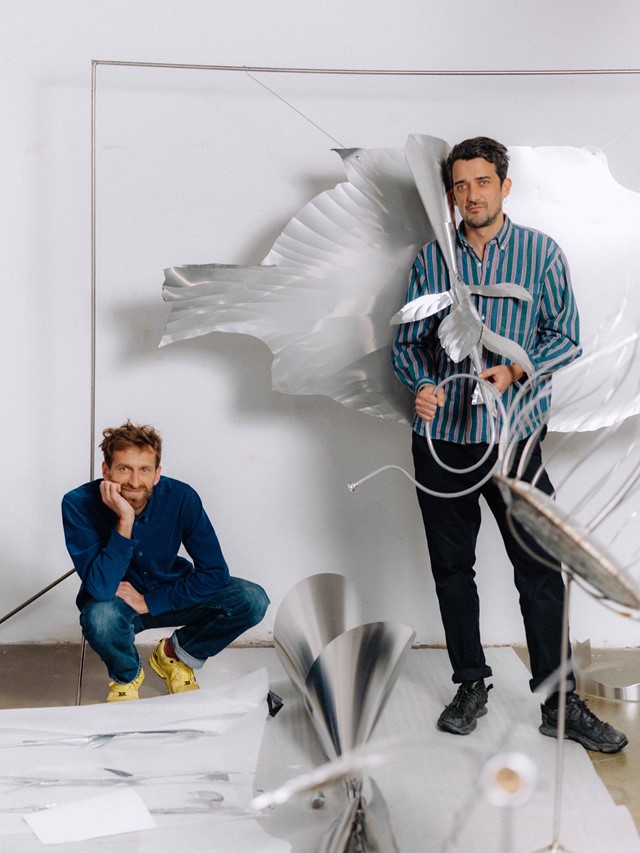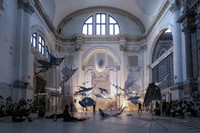Petrit Halilaj and Álvaro Urbano’s joyful new installation in an ancient Venice church addresses themes of queerness and climate change
Contemporary artists Petrit Halilaj and Álvaro Urbano first met on the dancefloor at Berghain, Berlin’s hallowed hardcore nightclub. “It’s a long story,” laughs Urbano. “We had a beautiful dance, but it wasn’t love at first sight,” says Halilaj. The pair, who are now married, are walking us through their latest joint artistic project: a shimmering, otherworldly installation in an ancient, crumbling Venice church called San Lorenzo. Lunar Ensemble for Uprising Seas, co-commissioned by TBA21–Academy and Audemars Piguet Contemporary, is part of the exhibition Thus waves come in pairs – curated by Barbara Casavecchia for Ocean Space – which also features sculptures by American-Lebanese artist Simone Fattal in a separate hall.
As one of the best destinations for art in the world, Venice has a long history of repurposing its magnificent Gothic, Byzantine, Renaissance and Baroque buildings into spaces for contemporary art; just think of Anish Kapoor’s recent takeover of a frescoed 16th-century palazzo, or Prada Fondazione’s Venetian outpost, open since 2011 – another palazzo overlooking the Grand Canal. For Halilaj and Urbano, responding to the space of San Lorenzo was a key first step for this site-specific commission, explains the project’s curator, Audrey Teichmann. “When the artists visited the space, their first reaction was that it was like a music box,” she says. “The church is built to make sound resonate in a very specific way.”
Both artists – who have separate practices but collaborate together on a project once every year – identify as gay, and their installation can be read as a testament to queerness. Lunar Ensemble for Uprising Seas is an ecosystem of sorts, with various aluminium sculptures welded into the shape of fictitious sea creatures dotted throughout the church’s vast, decaying hall, underneath an egg-shaped moon suspended above. When sunlight filters through the windows, light dances off the sculptures in a way that evokes rippling water or shoals of fish, giving the room the illusion of being submerged underwater. “The work is about trying to understand the other,” says Halilaj, referencing the sea-like creatures that are impossible to categorise. “The LGBTQI community in Italy has strong difficulties, so it’s important for us to be here. We believe there is space for everyone.”

The underwater theme of the installation was born from one of Urbano’s early memories; as a child, his grandmother would sing the popular Spanish folk song Ay mi pescadito to him, which was about young fish going to school at the bottom of the sea to learn how to survive. “[In the song] someone said to the little fish, stop crying, you have to go to the bottom of the ocean and learn how to resist. Later you will become a whale, and you will learn how to fly,” says Teichmann. “So this work is really about transformation, queering identities and futures.” The song Ay mi pescadito can be played from wind-up music boxes on the backs of a few sculptures – in fact, every sculpture in the church can be picked up and played as de facto musical instruments.
Once a month, 20 local, young performers will bring the installation to life, playing the sculptures-cum-instruments and parading them through the nearby Venice streets. Inspired by carnivals in Madrid (where Urbano hails from), the performance is both guttural and emotional, with musicians interacting with each other via whale-like sounds that feel as if they belong deep under the sea. Halilaj and Urbano weave among them dressed in head-to-toe seagull outfits, with yellow legs and webbed feet – a common wildlife staple of Venice streets overlooking the canals. As the music crescendos into a full-blown, shrieking cacophony, you get the sense that the artists had found their tribe in Venice – and a sense of belonging.
Thus waves come in pairs is on show at Ocean Space in Venice until 5 November 2023.






